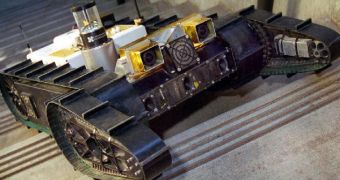A series of technologies and design methods previously used to create exploration rovers destined for other planets is now being used in a robot that is roaming the Fukushima Daiichi nuclear power plant. The machine is investigating areas where humans would be harmed by high radiation levels.
The advanced technologies were augmented with complex design techniques at the NASA Jet Propulsion Laboratory (JPL), in Pasadena, California. The lab, which is managed by Caltech, is in charge of handling the Mars Exploration Rovers (MER) Spirit and Opportunity.
When these twin robots were built, their overall design was inspired from that of Rocky-7, a testbed robotic platform that was developed at JPL for extraterrestrial missions. The same technologies used on this machine were used to create the new iRobot PackBot.
At this point, the instrument is being operated inside the four nuclear reactors at Fukushima that were heavily damaged by the March 11 earthquake and tsunami that struck the northeastern coasts of Japan.
Due to the massive scale of the devastation, some critically-important areas of the facilities are still off-limits to humans, but not for all robots. The PackBot is now proving that technologies originally developed for space can have multiple applications here on Earth as well.
Its structure is modeled after Rocky-7's with great accuracy, from the lightweight frame structure and sheet-metal chassis to the high-torque actuators that control the machine's movements.
In the aftermath of the magnitude 9.0 tremor that struck Japan, the JPL sent two PackBots to the Asian nation. Authorities there are using it to take radiation readings inside the damaged reactor buildings.
The data indicate that it's still unsafe for human repair crews to enter the facilities, and start their repair work. The nuclear power plant really took a devastating blow, especially from the tsunami wave that struck it shortly after the tremor was felt.
The two robots now being operated at Fukushima are equipped with multiple cameras and hazard material sensors, say experts at the JPL. This helps Japanese authorities monitor the situation at the four reactors closely and constantly.
JPL scientists say that these two machines are the emergency response versions of PackBot. The robot has been in use for nearly a decade, and is employed in active service by the US Army, Navy and Air Force. A military version of PackBot first saw action in Afghanistan, in 2002.

 14 DAY TRIAL //
14 DAY TRIAL //